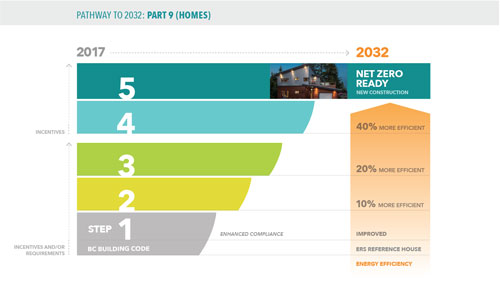Advancing the conversation on land and real estate issues in BC.
Insight: REIBC blog > BC Steps Up Energy-Efficient Construction
 |
Five steps to net-zero energy–ready construction. credit: Province of BC
|
Embedded inside the BC Building Code, the BC Energy Step Code—despite its name—is an option rather than a requirement for builders in BC. It’s a performance pathway that builders can choose instead of a prescriptive pathway, but make no mistake, energy-efficiency requirements are the destination, whichever road builders choose to get there.
“When deciding how to meet the requirements of the BCBC, most BC builders have pursued the prescriptive approach,” say Zachary May and Dale-Sofia Andersson of the Building and Safety Standards Branch for the Province of BC. “Following this approach, buildings must satisfy a checklist of individual requirements for insulation, windows, furnaces, water heaters, lighting, and other equipment and systems, but there is no requirement to evaluate how well these components work together as a system. The performance approach—the alternative option for complying with the energy-efficiency requirements of the BCBC—establishes design outcomes for the building as a system and leaves it to the design and building team to decide which materials and components best achieve the outcomes.”
The BC Energy Step Code, which came into force in April 2017, offers a specific form of this performance approach. It sets performance requirements grouped into “steps” that apply across different types of buildings. There are five steps for Part 9 residential buildings and three or four steps for Part 3 buildings, depending on the occupancy type. Starting with step one, each successive step means a higher level of energy efficiency. By 2032, all new construction will match the highest step for net-zero energy–ready buildings.
 |
| Download Spring 2019 |
What does this mean for local governments that already had energy-efficiency requirements in place? Find out in “Stepping Up BC’s Energy Efficiency” in the Spring 2019 edition of Input. Download Spring 2019
Join the conversation on Facebook
Read more about the BC Energy Step Code.
